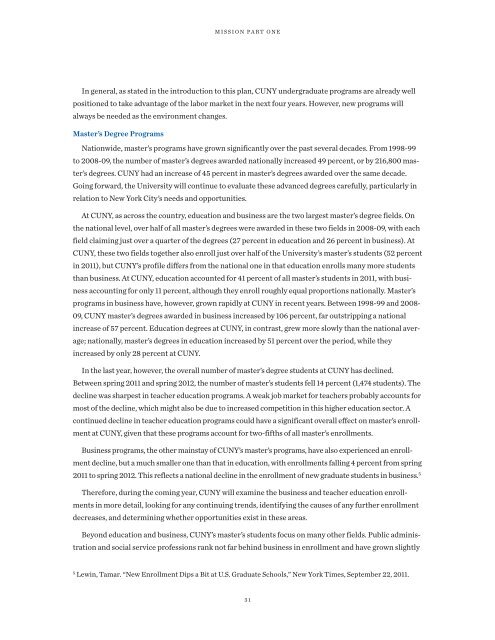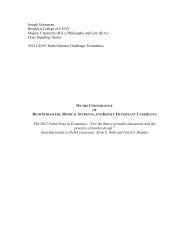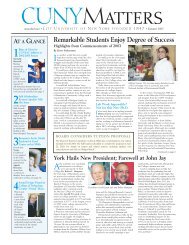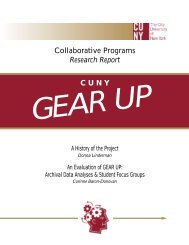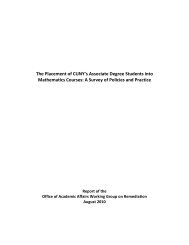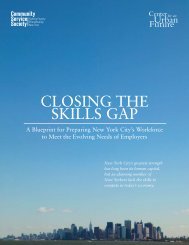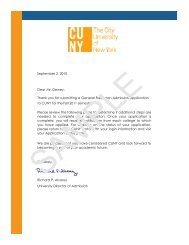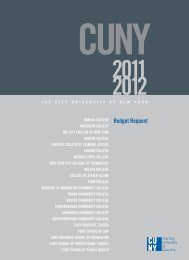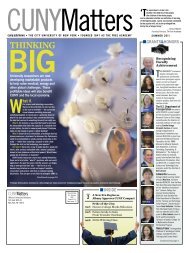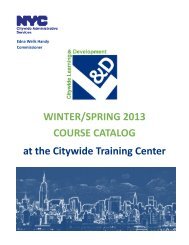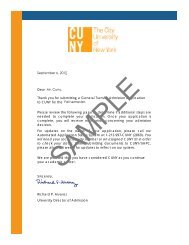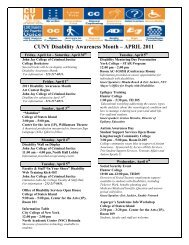CUNY Master Plan 2012-2016
CUNY Master Plan 2012-2016
CUNY Master Plan 2012-2016
Create successful ePaper yourself
Turn your PDF publications into a flip-book with our unique Google optimized e-Paper software.
MISSION PART ONE<br />
In general, as stated in the introduction to this plan, <strong>CUNY</strong> undergraduate programs are already well<br />
positioned to take advantage of the labor market in the next four years. However, new programs will<br />
always be needed as the environment changes.<br />
<strong>Master</strong>’s Degree Programs<br />
Nationwide, master’s programs have grown significantly over the past several decades. From 1998-99<br />
to 2008-09, the number of master’s degrees awarded nationally increased 49 percent, or by 216,800 master’s<br />
degrees. <strong>CUNY</strong> had an increase of 45 percent in master’s degrees awarded over the same decade.<br />
Going forward, the University will continue to evaluate these advanced degrees carefully, particularly in<br />
relation to New York City’s needs and opportunities.<br />
At <strong>CUNY</strong>, as across the country, education and business are the two largest master’s degree fields. On<br />
the national level, over half of all master’s degrees were awarded in these two fields in 2008-09, with each<br />
field claiming just over a quarter of the degrees (27 percent in education and 26 percent in business). At<br />
<strong>CUNY</strong>, these two fields together also enroll just over half of the University’s master’s students (52 percent<br />
in 2011), but <strong>CUNY</strong>’s profile differs from the national one in that education enrolls many more students<br />
than business. At <strong>CUNY</strong>, education accounted for 41 percent of all master’s students in 2011, with business<br />
accounting for only 11 percent, although they enroll roughly equal proportions nationally. <strong>Master</strong>’s<br />
programs in business have, however, grown rapidly at <strong>CUNY</strong> in recent years. Between 1998-99 and 2008-<br />
09, <strong>CUNY</strong> master’s degrees awarded in business increased by 106 percent, far outstripping a national<br />
increase of 57 percent. Education degrees at <strong>CUNY</strong>, in contrast, grew more slowly than the national average;<br />
nationally, master’s degrees in education increased by 51 percent over the period, while they<br />
increased by only 28 percent at <strong>CUNY</strong>.<br />
In the last year, however, the overall number of master’s degree students at <strong>CUNY</strong> has declined.<br />
Between spring 2011 and spring <strong>2012</strong>, the number of master’s students fell 14 percent (1,474 students). The<br />
decline was sharpest in teacher education programs. A weak job market for teachers probably accounts for<br />
most of the decline, which might also be due to increased competition in this higher education sector. A<br />
continued decline in teacher education programs could have a significant overall effect on master’s enrollment<br />
at <strong>CUNY</strong>, given that these programs account for two-fifths of all master’s enrollments.<br />
Business programs, the other mainstay of <strong>CUNY</strong>’s master’s programs, have also experienced an enrollment<br />
decline, but a much smaller one than that in education, with enrollments falling 4 percent from spring<br />
2011 to spring <strong>2012</strong>. This reflects a national decline in the enrollment of new graduate students in business. 5<br />
Therefore, during the coming year, <strong>CUNY</strong> will examine the business and teacher education enrollments<br />
in more detail, looking for any continuing trends, identifying the causes of any further enrollment<br />
decreases, and determining whether opportunities exist in these areas.<br />
Beyond education and business, <strong>CUNY</strong>’s master’s students focus on many other fields. Public administration<br />
and social service professions rank not far behind business in enrollment and have grown slightly<br />
5<br />
Lewin, Tamar. “New Enrollment Dips a Bit at U.S. Graduate Schools,” New York Times, September 22, 2011.<br />
31


